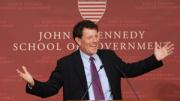If those who cannot remember the past are condemned to repeat it—as philosopher George Santayana, A.B. 1886, once wrote—and if news reports provide a first rough draft of history—as Philip Graham, LL.B. ’39, the late publisher of the Washington Post, said in 1963—then today’s teenagers may be setting their generation up for a lifetime of mistakes by avoiding the news.
Recent research by Thomas E. Patterson, Bradlee professor of government and the press at the Kennedy School of Government, found that teenagers not only pay far less attention to news than adults do, but also that they engage less deeply with news sources: skimming headlines instead of reading full stories, or channel-surfing instead of watching an entire newscast. Among teens, 60 percent paid minimal or no attention to news; for adults 30 or younger, the figure was 48 percent, and for older adults, 23 percent.
Although surveys of media use are common, those that poll teenagers are less so. Furthermore, Patterson believes his survey provides a more accurate barometer of news consumption than previous studies for several reasons, including its relatively large number of respondents (1,801)—approximately 600 in each of the three age groups—and its polling methods. Instead of assessing people’s engagement with the news by asking how many minutes they spend reading a newspaper or watching TV—figures people rarely keep track of in the first place—Patterson asked his subjects to classify their use according to one of two categories: “skimming” through news sections and glancing at the headlines, or reading “quite a few stories.” (Appropriate equivalents were used for other media.)
The survey also included a pop quiz. Not only did it ask whether people were familiar with a given news story from the previous 24 hours (e.g., “Do you recall a news story about the death of a famous race horse?”), it also asked about a specific detail (“Do you recall whether the horse died of natural causes or whether it was put to death because of injury?”), creating a shibboleth for any respondents tempted to inflate their own level of attention.
Teens scored lowest on this indicator, as well: 62 percent of adults over 30, 43 percent of young adults, but only 33 percent of teens claimed to be familiar with the news story about which they were asked. Teens were also more likely to get the question wrong even if they claimed familiarity—only 50 percent of them answered correctly, compared to 60 percent for the older age groups.
One surprising finding: Patterson found much less reliance on the Internet as a news source than he expected. Among people who claimed familiarity with a given news story, teens were no more likely than young adults to have first encountered it on the Web. In both age brackets, only 18 percent claimed to have read it there first. The percentage of teenagers who had first seen the story on TV—41 percent—dwarfed that figure. More teenagers also learned of news stories by word of mouth: 28 percent, compared to 12 percent for young adults and just 4 percent for older adults. Also “conspicuously missing” from the list of important news sources for teens and young adults were “alternative news sources” such as the Daily Show and other programs that mix news and comedy. (A 2004 study by the Pew Research Center for People and the Press famously found that Americans between the ages of 18 and 29 relied more heavily on such shows for news about the presidential campaign than they did on Internet news sites.) “The notion that young adults get their news from ‘a different distribution system’ is not borne out by our evidence,” Patterson writes. “A shift in sources is occurring, and it is in the direction of the new media, but the larger tide has been the movement away from a daily news habit.”

Some news reports cast Patterson’s findings in a positive light, pointing out that 54 percent of the teenagers surveyed reported at least skimming a newspaper “less than once a week” or more frequently (as opposed to “hardly ever” or “never”). The numbers for other media were even higher. But Patterson says that glancing at a newspaper once every two weeks is not enough to make informed citizens. “This report,” he concludes, “will be a source of unease for those concerned about journalism and democracy in America.”
To those who say teens have never cared about the news, Patterson offers similar surveys, predating cable TV, that show young Americans’ awareness of the news was much closer to that of adults. For instance, Martin P. Wattenberg, a political scientist at the University of California-Irvine, notes in his book Is Voting for Young People? that in 1967, 64 percent of respondents who were 15 to 24 watched a network news broadcast nightly, compared to percentages ranging from 68 to 79 for older adults.
Patterson believes this was due to what he calls “force feeding” of news—an entire generation of teenagers who wanted to watch TV watched the news for an hour each evening because that was all that was on. Today’s teenagers have cable, personal TV sets in their bedrooms, or both. Although some percentage of teens will undoubtedly take greater interest in the news once they grow up and realize its importance, teens as a group, Patterson concludes, are not developing the “news habit” their parents’ generation did. He ends the report with a quotation from Aristotle: “We are what we repeatedly do.”
~Elizabeth Gudrais






